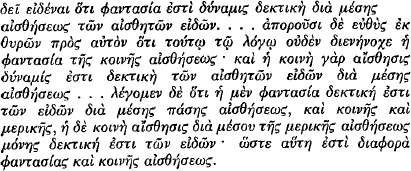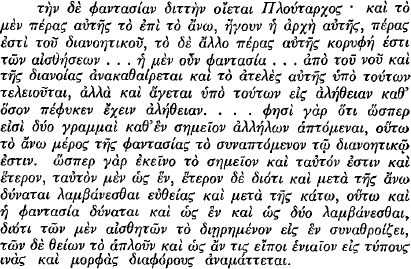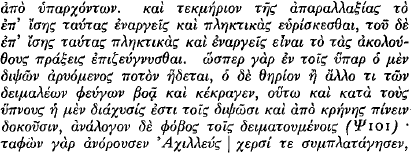Article contents
Al-Fārābī's Theory of Prophecy and Divination
Published online by Cambridge University Press: 23 December 2013
Extract
It is the purpose of this paper to draw the attention of classical scholars to an Arabic theory of prophecy and divination which, though known for a long time in the original text and in modern translation, has quite escaped the notice of those interested in the history of late Greek philosophy and its continuation in mediæval Islam. I mean here by prophecy and divination, like the Arabic author I am going to deal with, all kinds of apparently supernatural knowledge, concerned with the realm of the transcendent as well as with particular events in the future and special happenings at the present time. The possessors of this knowledge are characterised as individuals of a peculiar excitability and a range of imagination which exceeds the normal. Attempts at explaining phenomena of this kind in rational terms were not uncommon in Greek philosophy from Plato's days down to late Neoplatonism. I propose to show that the Arabic theory continues these Greek discussions and to suggest that it represents, at the same time, a facet of Greek thought which has not survived in its original context.
Al-Fārābῑ (c. A.D. 870–950), a well-known Muslim Neoplatonist and Aristotelian of outstanding importance in the history of Islamic philosophy, deals at some length with prophecy in his work The Views of the People of the Best State. Since, in accordance with the Greek tradition, he connects divination and prophecy with an innate faculty of the soul itself, and does not describe it as a state of possession by supernatural powers, his explanation of these phenomena is linked up with his analysis of man and his Neoplatonic-Aristotelian metaphysics. Prophecy is auxiliary to the rational faculty and as such an indispensable ingredient in man's perfection; divine inspiration (wahy) can be understood as the union of the highest philosophical knowledge with the highest form of prophecy; but the primacy of reason and philosophy is maintained, prophecy being confined to the faculty of imagination, which is given a less humble position than in Aristotle's De anima, but still ranked as inferior to philosophy.
- Type
- Research Article
- Information
- Copyright
- Copyright © The Society for the Promotion of Hellenic Studies 1957
References
1 Cf. e.g. Walzer, R. in The History of Philosophy: East and West (London 1953), vol. 2, pp. 136 ff.Google ScholarBrockelmann, C., Geschichte der arabischen Litteratur I (Leiden 1943), pp. 232 ff.Google Scholar
2 The classical Arabic language has no word for ‘citizen’ πολίτης, and the translators of Greek texts had to face this difficulty. Cf. Sir Hamilton Gibb, The Evolution of Government in Islam, Early, Studia Islamica, 4, pp. 5–18.Google Scholar
3 This paper is based on chapters 20–25 and 27 of the work, and more specifically on chapters 24 and 25. The text is available in a not very satisfactory Arabic edition by F. Dieterici (Leiden 1895), in a German translation by the same scholar (Al-Fārābῑ, Der Musterstaat, Leiden 1900) and in a French translation (Janssen, R. P., Karam, Youssef et Chlala, J., Al-Fārābées des habitantsde la cité vertueuse, Cairo 1949).Google Scholar References to special passages indicate Dieterici's Arabic text andcan be easily verified in his German translation.
4 Cf. Encyclopedia of Islam, s.v., and recently Bell, R., Introduction to the Qur'ān (Edinburgh 1953), pp. 31 ff.Google Scholar, who shows that waḥy and the actual text of the Koran are to be considered as two different things. Cf. also Massignon, L. in Festugière, , La révélation d'Hermès Trismégiste (Paris 1950), p. 385.Google Scholar Al-Fārābῑ fully realised that his philosophical definition of waḥy is opposed to the way in which it is understood by tradition and speculative theology, cf. his De divisione scientiarum, V, p. 108, ii f. (ed. Amin, Osman)Google Scholar and Gardet, L. and Anawati, M. M., Introduction à la Théologie Musulmane (Paris 1948), p. 104 f.Google Scholar
5 The work was available to Al-Fārābῑ in a ninth-century Arabic version by Isḥāq, son of Ḥunain (cf. Supplementum Aristotelicum II, pp. xiv ff. Bruns) and was commented upon by him in a special work of his own (cf. Ibn al-Qifṭῑ, p. 279, 22 Lippert). Some lost works by Alexander have been discovered in Arabic versions and published (but not translated into a European language); some more have been recently traced in Istanbul, (cf. Festschrift Bruno Snell, München 1956, p. 190).Google Scholar
6 There is some slight late Greek evidence for this theory, as is shown by Bergh, S. van den, Averroes' Tahāfut al-Tahāfut, vol. II (London 1954), p. 74Google Scholar; but we can trace a similar conception of the First Cause back to Middle Platonism, cf. Albinus, , Isagoge 9Google Scholar (p. 163, 29 Hermann = IX 3, p. 53 Louis) and 10.
7 
8 Cf. ‘Nemesius of Emesa’, De nat. hom., p. 177, 3: ![]()
![]() Jaeger, W. W., Nemesios von Emesa (Berlin 1914), p. 21.Google Scholar
Jaeger, W. W., Nemesios von Emesa (Berlin 1914), p. 21.Google Scholar
9 Cf. also Al-Fārāb's metaphysics E–N could be accepted as the work of Alexander (cf. Freudenthal, J., Die durch Averroes erhaltenen Fragmente Alexanders zur Metaphysik, Berlin 1885Google Scholar, passim). Recent research has shown that Proclus could pass for Alexander in Arabic tradition, cf. Lewin, B., Notes sur un texte de Proclus en traduction arabe, Orientalia Suecana 4, 1955, pp. 195 ff.Google Scholar, and Pinès, S., Une version arabe de trois propositions de Proclus, Oriens 8, 1955, pp. 195 ff.Google Scholar That extracts from a paraphrase of Plotinus (the so-called Theology of Aristotle) and a work based on Proclus' Elements of Theology (the De causis) were attributed to Aristotle by the Arabs is well known.
11 Which was accepted by Philo, De fuga, §166; Quis rer. div. heres, §259. Cf. also Leisegang, H., Der heilige Geist, I i (Leipzig 1919), p. 146.Google Scholar
12 The ![]() can then be likened to the Angel of Revelation, to Jabra'il (cf. Encyclopedia of Islam, s.v. Djabra'il and Mala'ika) or to the Qur'anic Holy Spirit or Trustworthy Spirit (cf. Al-Fārābῑ, , Siyāsāt, p. 3Google Scholar).
can then be likened to the Angel of Revelation, to Jabra'il (cf. Encyclopedia of Islam, s.v. Djabra'il and Mala'ika) or to the Qur'anic Holy Spirit or Trustworthy Spirit (cf. Al-Fārābῑ, , Siyāsāt, p. 3Google Scholar).
13 It is only after death that the souls of those who have reached the utmost perfection join the Active Intellect, which then corresponds to the ‘Kingdom of Heaven’ in Islamic theological language (cf. Al-Fārābῑ, , Mādῑna, p. 58, 18Google Scholar; 59, 3; Siyāsāt, p. 3, and Encyclopedia of Islam, s.v. Malakῡt and Djabarῡt).
14 Cf. Dodds, E. R., The Greeks and the Irrational, Berkeley 1951, p. 286.Google Scholar
15 Cf. also E. R. Dodds, op. cit., p. 291. Al-Fārābῑ thus differs from Al-Ghazzālῑ and Maimonides who both accepted ![]() (ittiḥād) in the case of exceptional human beings.
(ittiḥād) in the case of exceptional human beings.
16 Cf. e.g., Ritter, H., Das Meer der Seele (Leiden 1955), pp. 499, 575.Google Scholar
17 Cf. also Walzer, R., ‘Some Aspects of Miskawaih's Tahdhῑb al-Akhlāq in Studi Orientalistici in onore di G. Levi della Vida, vol. II (Roma 1956), pp. 608 ff.Google Scholar
18  (Cf. Pauly-Wissowa-Kroll s.v. Plutarchos von Athen).
(Cf. Pauly-Wissowa-Kroll s.v. Plutarchos von Athen).
Cf. Proclus, , In Crat., 129Google Scholar (p. 76, 26 Pasquali): ![]()
![]() In Remp., I, p. 39, 28 Kroll: Gods appear in human shape as
In Remp., I, p. 39, 28 Kroll: Gods appear in human shape as ![]()
![]() of their true being.
of their true being. ![]()

![]()
For Iamblichus, cf. Lydus, Priscianus, Metaphr., p. 23, 13 ff.Google Scholar Bywater: ![]()
![]() and p. 24, i ff. Simplicius, , De an., p. 214, 18 ff.Google Scholar Hayduck.
and p. 24, i ff. Simplicius, , De an., p. 214, 18 ff.Google Scholar Hayduck.
19 Plutarch, , De libidine et aegritudine 6Google Scholar (Moralia, vol. VI, 3, p. 41 Pohlenz): ![]()
![]() (scil.
(scil. ![]() )
) ![]()

![]() Cf. Reinhardt, K., Poseidonios (München 1921), p. 313, n. 1.Google Scholar
Cf. Reinhardt, K., Poseidonios (München 1921), p. 313, n. 1.Google Scholar
20 Quaest. Conv. V 7. 3. p. 681D: ![]()

21 Enn. III 6. 3. 1. 6–16 Henry-Schwyzer. Cf. also Priscianus Lydus. Metaphr., p. 25. 1 ff. Bywater.
22 Cf. above n. 20 and also ‘the philosophers’ as quoted by Al-Ghazzālῑ in Averroes', Tahāfut al-Tahafut, p. 513Google Scholar = vol. I, p. 314 of the English translation by S. van den Bergh (London 1954), and n. 2.
23 Cf. Krause, H., Studia Neoplatonica (Diss. Leipzig 1904), p. 19Google Scholar, and Theiler, W., Porphyries und Augustin, Königsberg 1933, p. 38.Google Scholar
24 ![]()

![]()
25 The section on φαντασία in Ps.-Longinus, , De subl. 15Google Scholar, is interesting in this context and deserves to be considered.
26 Cf. Panofsky, E., Idea (Leipzig–Berlin 1924), p. 8 and n. 37.Google ScholarCf. also Schweitzer, B., ‘Der bildende Künstler und der Begriff des Künstlerischen in der Antike’, Neue Heidelberger Jahrbücher, 1925, p. 110 f.Google Scholar
27 Cf. Theiler, W., Vorbereitung des Neuplatonismus (Berlin 1930), pp. 15 ff.Google ScholarJucker, H., Vom Verhältnis der Römer zur bildenden Kunst der Griechen (Frankfurt 1950), pp. 137 ff.Google Scholar K. Reinhardt, Pauly-Wissowa-Kroll s.v. Poseidonios, col. 772. Cf. also above n. 18 and Proclus In Tim. I, p. 265, 22: ![]()

![]()
28 Is it rash to assume that the Platonic tradition on which Al-Fārābῑ here ultimately depends interpreted Plato as recognising ideas of the αἰσχρόν and κακόν? This would be an interesting point. Al-Fārāb's ideal doctrine.
29 These two kinds of reason are distinguished in Greek thought since the days of Aristotle and accepted by Alexander and all the late Greek philosophers.
30 Cf. e.g., Aristotle, De divin. 2, 464332: ![]()
![]()
![]() Eth. Eud. VIII. 2, 124a39:
Eth. Eud. VIII. 2, 124a39: ![]()
![]() [Aristotle] Probl. XI 38, 903b20:
[Aristotle] Probl. XI 38, 903b20: ![]()
![]() XXX 1, 953a 10 ff:
XXX 1, 953a 10 ff: ![]()
![]()
![]() Regenbogen in Pauly-Wissowa-Kroll s.v. Theophrastos von Eresos, col. 1402 f.
Regenbogen in Pauly-Wissowa-Kroll s.v. Theophrastos von Eresos, col. 1402 f.
31 P. 51, 14 ff. Dieterici.
32 P. 51, 20 ff. I translate my own forthcoming critical edition of the Arabic text.
33 P. 52, 4 ff. and Plotinus, Enn. I 5. 4,. l. 15 f. Henry-Schwyzer. Cf. n. 1.
34 Cf. Encyclopedia of Islam, s.v. Nabῑ.
35 P. 52, 11 ff.
36 Cf. ‘New Light on Galen's Moral Philosophy’, Classical Quarterly, 1949, p. 84 and n. 4.
37 Cf., e.g. cap. 28.
38 Cf. n. 33 and the well-known pre-Islamic prophets which are recognised: Cf. Encyclopedia of Islam, s.v. Dāwud, Hῡd, Ibrāhῑm, Idrῑs, Ilyās, Irmiyā, ‘Ῑsā, Isrā'ῑ;l, Lῡṭ, Mῡsā, Nῡḥ, Sāliḥ, Shu'aib, Sulaimān, Yῡnus.
39 Islām knows, e.g., al-Aswad, Musailima, Sadjāh, Ṭulaiḥa as false prophets; cf. Encyclopedia of Islam, s.v.
40 Cf. above n. 4.
41 Rahman, F., Avicenna's Psychology (Oxford 1952), pp. 35 ff., 93 ff.Google Scholar S. Van den Bergh, op. cit., I, pp. 313 ff. and notes.
42 Cf. Watt, W. Montgomery, The Faith and Practice of Al-Ghazali (London 1953), pp. 63 ff.Google Scholar
- 11
- Cited by


